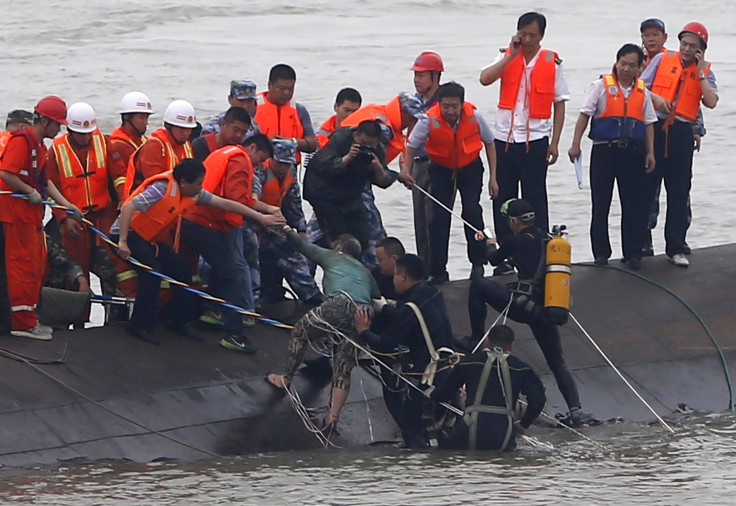At Least 5 Dead In Chinese Cruise Ship Capsize; Over 400 People, Mainly Elderly Tourists, Still Missing

SHANGHAI -- A massive rescue operation is continuing on the Yangtze River in central China's Hubei Province, in an attempt to find survivors among some 440 people still missing after a cruise ship capsized on the river on Monday night. By early evening on Tuesday, some 22 hours after the accident, 15 of the 458 people on board the boat were reported to have been rescued, including seven people who had swum ashore immediately after the accident. The ship's captain and chief engineer, who were among the survivors, have been detained by police as investigations into the cause of the accident get underway.
On Tuesday afternoon, Chinese state television showed a 65-year-old woman being pulled out alive from the upturned hull of the ship, and a military diver explaining how he had cut free a 21-year-old man who had been trapped in an air pocket inside the vessel. Chinese media also reported that rescuers were "racing against time" to free several other people believed to be alive inside the hull.
A spokesman for the local military command, Chen Shouming, said in a televised news conference on Tuesday evening that the number of frogmen at the scene had now risen to more than 180, and they would keep working through the night in the hope of finding more survivors. Some frogmen had entered the body of the ship and were trying to open the doors of individual bedrooms on board, according to Shanghai news website The Paper.
In total some 4,000 people are now involved in the rescue effort, China's transport minister Yang Chuantang said at the news conference, and some 90 boats are reported to be searching a long section of the river downstream from the site of the accident. Several of the bodies of those confirmed to have died were recovered some 35 miles downstream in neighboring Hunan province.
China's Premier Li Keqiang has also rushed to the scene, in a sign of just how seriously the authorities are taking the accident, which could be China's worst shipping disaster since the late 1990s. River traffic in the area was halted, and sluice gates at the huge Three Gorges Dam, further upriver, were adjusted to reduce water levels and aid the rescue effort.
However, analysts quoted by state television said the difficult conditions on the river, where heavy rains began again on Tuesday afternoon, were making rescue work harder. And while experts said there was a possibility that more people were still alive in air pockets in the vessel, Huang Jianwei, a senior official at the Shanghai Maritime Safety Bureau, told the Shanghai Daily newspaper that the situation was "hardly optimistic."
The boat, the Eastern Star, was carrying 458 people, including 406 mainly elderly Chinese tourists, on a river cruise from the eastern city of Nanjing to Chongqing, when it was hit by a tornado on Monday evening. Reports say the accident occurred as many of the passengers were going to bed, and the vessel overturned within just one or two minutes, leaving the crew no time to sound a warning signal. A report from Xinhua said that the ship was not overloaded and was equipped with enough life jackets for those on board. However, rescue efforts were hampered by heavy rains, which flooded some roads and fields near the scene overnight, and by large waves on the river, as well as by the fact that the accident happened some 2.5 miles from the nearest port.
The 76.5-meter vessel was a luxury cruise ship with four levels of cabins, as well as restaurants, karaoke and other leisure facilities. However, the deputy head of Shanghai’s Maritime Safety Bureau’s direction center, Zhu Genghao, told Shanghai’s Dragon TV that tour boats on the Yangtze had a shallow draft, which may have contributed to the boat being overturned by what he called a “disastrous wind.”
Reports said the passengers were mostly aged between 50 and 80, with the youngest a three-year-old boy. Most had booked their tours through a Shanghai-based company, Xiehe Travel. State TV said that 97 of the passengers were from Shanghai, and 204 from neighboring Jiangsu province; the rest came from other Chinese provinces.
Some family members gathered at the dockside in Jiangsu's provincial capital, Nanjing, from where the boat departed, seeking more information. Other relatives went to the travel agency's office in Shanghai -- though the agency's staff were reported to be en route to Hubei to visit the scene of the disaster. One family member told the Shanghai Daily that his wife and 20 of her neighbors had been on board the boat.
Premier Li was shown on state television urging officials to provide all assistance necessary to families of those on the boat, and to coordinate compensation as required. The government's high-profile response follows a number of disasters in recent years, in which Chinese authorities have been criticized for their slow response.
China’s President Xi Jinping also issued a statement calling on officials to learn lessons from the accident. Only last week, he urged top officials to make “every effort to ensure public safety,” following a string of disasters in recent months, including the death of 38 people in a fire at a home for the elderly in Henan province last week, a bus crash in Shaanxi province, which killed 35 people last month, and a stampede on Shanghai’s Bund waterfront on New Year’s Eve, which left 36 people dead. Twenty-two people also died when a tugboat sank further downstream on the Yangtze in January.
Shanghai-based news website The Paper, meanwhile, published images of the scene of the accident with a black border, accompanied by mournful music, and a message saying, "We pray that the trapped passengers will be safely rescued from danger."
© Copyright IBTimes 2024. All rights reserved.






















